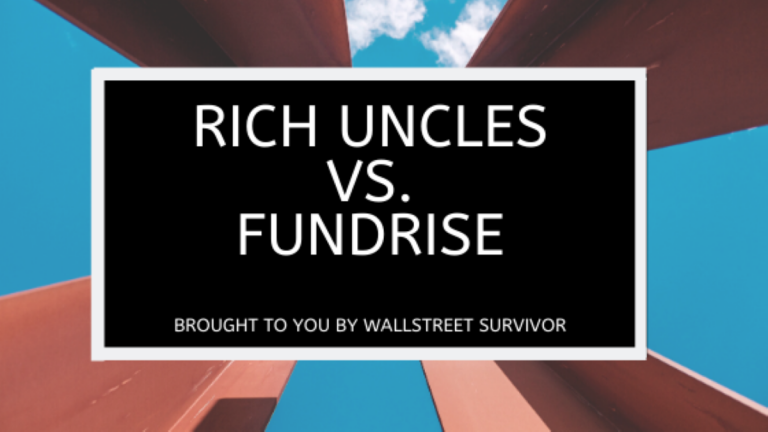Diversify, diversify, diversify.
Diversification is one of THE cardinal rules of investing.
So, all you need is a balanced portfolio of stocks, bonds, mutual funds, ETFs, and cash — right?
Wrong!
Many investors miss a big piece of the puzzle — real estate.
The trouble with real estate is that it’s a whole different animal than stocks or bonds.
Real estate is so much more than watching numbers on a ticker tape.
It’s illiquid. It’s tactile. It’s messy. It involves fixing toilets.
To put it simply: real estate is “real.”
In the past, investing in real estate required a lot of market knowledge and upstart capital — exponentially more for commercial real estate.
It involves a lot of risk, since investors own the individual property, and their returns tank if the market turns south or a tenant doesn’t pay rent.
And while the returns are tempting, many people don’t want to take on managing tenants, collecting rent, and fixing furnaces in the dead of winter at 2 a.m. to get them.
Enter REITs.
An Overview of REITs
REITs (real estate investment trusts) have changed the face of real estate investing.
Simply put, REITs are organizations that pool money from many investors to own and manage investment properties.
The REIT takes care of everything from acquisitions to day-to-day management of the properties.
Investors own shares of the REIT, which pay them dividends — all while letting them blissfully slumber through the 2 a.m. furnace repairs.
REIT investors earn dividends and appreciation from their shares (much like dividend-paying blue chip stocks).
The risk is also spread out over several properties, often in different sectors (similar to a mutual fund).
Some REITs are publicly traded on the stock exchange; others are open only to private (often very wealthy) individuals.
Many times, private REITs have better returns than public ones, but minimums to invest in private REITs are very high.
Crowdfunded REITs
Recently, crowdfunded private REITs like Rich Uncles and Fundrise have changed the face of private REITs.
Instead of saving tens of thousands of dollars for a private REIT investment, investors can invest in multi-million-dollar real estate deals from a mobile phone for as little as $5.
Dozens of crowdfunded REIT platforms have emerged over the past few years.
With many different structures and niches, it can be difficult to determine which REIT best fits your investment strategy, risk tolerance, and goals.
Today, we host a face-off between two of the most popular REIT platforms in play today: Rich Uncles vs. Fundrise.
Rich Uncles vs. Fundrise: Similar Features
Both Fundrise and Rich Uncles offer wealth creation through 3 different channels:
- appreciation of real estate properties;
- rental income; and
- tax savings (buildings depreciate over time, and some of this “cost” is tax deductible).
Both platforms allow you to sign up online quickly and get started investing right away.
Each service requires a minimal initial investment compared to traditional private REITs, although their minimums vary widely.
Fundrise and Rich Uncles hold illiquid investments.
However, each company offers buy back opportunities for investors desiring to liquidate their shares.
Also, neither platform requires you to be an accredited investor.
This is true of many private REITs, which until now would bar many average Janes and Joes from investing in these multi-million-dollar deals.
Both Fundrise and Rich Uncles now allow the average investor access to these deals.
The Story of Fundrise

The founders of Fundrise were fed up with old inefficiencies of private real estate investing.
They set out to democratize access to a multi-billion-dollar asset class by using technology.
The use of technology allowed investors to cut out unnecessary expenses and overhead, passing the savings on to their investors.
Minimum Investment
With Fundrise, you can get started with a minimum $500 investment in a Starter Portfolio.
Once you have invested $1000, you can upgrade to one of Fundrise’s 3 Core Plans:
- Supplemental Income
- Balanced investing
- Long-term growth
Subsequent deposits must be $100 or more, and you can set this up from your bank.
Fees
Fundrise charges the following fees:
- 1% – .85% for annual asset management; and
- .15% investment advisory fee (which may be waived under some circumstances).
Fundrise contends that their fees are 20-40% lower than comparable investments.
Any additional charges or fees are buried deep in the legalese of their offering circulars.
Investment Options
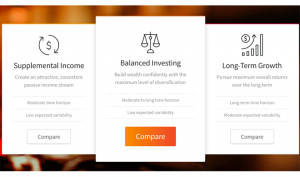
The most basic options for investors to start with is the Starter Portfolio.
The investments in this plan are categorized as half growth and half income.
Investors don’t get to choose individual REITs until they enroll in a Core Plan.
Fundrise offers 3 Core Plans, where you have a few more options to customize your investments.
The Core Plans are as follows:
- Supplemental Income Plan focuses on dividends;
- Long-Term Growth Plan emphasizes total return; and
- Balanced Investing Plan blends the Supplement Income Plan and Long-Term Growth Plan together.
Within each Core Plan, the investor chooses a specific eREIT (think an ETF, only for real estate) that aligns with his/her goals.
An eREIT may focus on a particular geographic area (like the East Coast or Los Angeles) or on an investment objective (like the Income eREIT).
At the time of this writing, Fundrise is only available to U.S. residents.
Customer Service
A common feature of crowdfunded REITs is slimming down the org chart to eliminate middlemen and overhead.
However, Fundrise has passed the point of diminishing returns.
One major downside to Fundrise is that you can only communicate with them via email (or snail mail, if you’re into that sort of thing).
They have mastered technology-enabled management to allocate new assets, but they haven’t managed to get a chatbot or phone number on their website.
Hopefully, this will change in the near future.
Liquidating Assets
Fundrise offers a 90-day money-back guarantee to buy back your shares at 100 percent of the purchase price.
This is a great way to “try before you buy” in real estate investing with no risk of losing your principal for the first three months.
While this no-risk introductory period is a tempting offering, remember that REIT shares should be considered highly illiquid, since there is no secondary market like the NYSE on which they can be traded.
Fundrise allows you to submit a request to liquidate your shares whenever you like, but you will wait upwards of two months to get your money.
And there is a decreasing fee structure for pulling your money out early:
- 3% for accounts 90 days to 3 years old;
- 2% from 3-4 years; and
- 1 % from 4-5 years.
(There is no fee for withdrawing funds over 5 years old).
Deep in the legalese of the website, Fundrise notes that the company has no requirement to liquidate your shares, even if you request it; i.e., if you invest in Fundrise, be prepared to hold your shares indefinitely.
REITs are not short-term investments.
Dividend Payments
Fundrise pays dividends quarterly with the option to reinvest dividends automatically.
Historical Rate of Return
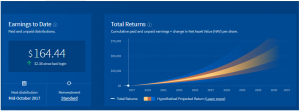
This is calculated as dividends plus appreciation.
After management and other fees, Fundrise has provided investors returns of 8.76% to 12.42% since it started in 2012.
Fundrise owns over $2.5 billion in real estate assets at the time of this writing.
The Story of Rich Uncles

Formed in 2012 by “Uncle” Ray Wirta and Harold Hofer, Rich Uncles has an impressive leadership team with executive experience in large real estate and investment firms.
The tenants in properties owned by Rich Uncles sign triple net leases, meaning they pay for taxes, insurance, utilities, and maintenance.
The fact that tenants absorb these costs translate to lower operating overhead for Rich Uncles and its investors.
Minimum Investment
The minimum investment required for Rich Uncles depends on the REIT you choose.
The BRIX REIT only requires $5 as an initial investment.
The NNN REIT requires an investment minimum of $500, with subsequent investments being $50 or more.
Investment Options
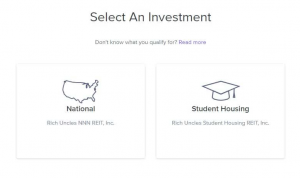
Only two REITs are currently available for new investors at the moment: the BRIX REIT and the NNN REIT.
The BRIX REIT focuses on student and multi-family housing, quick-service restaurants, convenience stores, and fitness centers.
It’s available to investment across the U.S. and internationally.
The NNN REIT focuses on single-tenant office, industrial, and retail properties leased to nationally recognized corporate tenants.
It is available to investors from a list of 24 U.S. states only.
(If you are not in the U.S., be sure to read the prospectus on the REIT you are interested in, as the website gives mixed messages on whether or not foreign investors can participate in the Rich Uncles REITs.)
Customer Service
Rich Uncles shines when it comes to customer service options.
Whether you prefer email, chatbot, telephone, or snail mail, Rich Uncles has you covered.
Ease of communication is a unique feature, as many companies cut costs by reducing their customer service profile.
Liquidating Assets
Rich Uncles does not have the 90-day money-back guarantee like Fundrise does, but their fee structure for those wanting to liquidate shares is more favorable:
- 3% for funds are less than a year old
- 2% if they are between 1 and 2 years old
- 1% if they are between 2 and 3 years old
(There is no penalty if your funds are over 3 years old.)
You must alert Rich Uncles before the last three business days of the month if you wish to liquidate your shares.
They will be repurchased on the third business day of the month.
This definitely beats Fundrise’s 60+ day repurchase program.
Like Fundrise, however, Rich Uncles has no requirement to liquidate your shares.
(Their website is a little more transparent with that fact, however.)
Dividend Payments
Rich Uncles distributes dividends on a monthly basis.
Historical Rate of Return
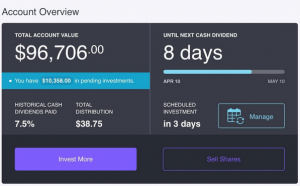
Rich Uncles gets a major ding on this one.
The company was founded in 2012, but their website gives no information on historical rate of return for any of their REITs.
They do give numbers on projected annualized rates of return in the 6-7% range.
Rich Uncles does provide information on income, expenses, and dividends paid for individual REITs.
However, these are hidden in the 200+ page circulars on the website, so be prepared to do your due diligence before investing.
Management Fees
Rich Uncles gets a gold star for no up-front management fees. No fees means all of your investment dollars go to … uh … your investments. (That’s how it’s supposed to work, right?)
More investments mean higher dividends, which means more cash in your pocket.
Rich Uncles’ structure is unique in that they pay out the first 6.5% of profits to investors, and the remaining profits are split 60/40 between you and Rich Uncles.
While this performanced-based model doesn’t guarantee your return, it does guarantee that you get the first cut of the profits.
Rich Uncles vs. Fundrise: And the winner is….
Drum roll, please…
…Rich Uncles!
Rich Uncles’ is an excellent option because of the company’s:
- no-fee model;
- lower minimum investment requirements;
- improved penalty structure for repurchasing shares; and
- variety of customer service options.
The above reasons make Rich Uncles our preferred crowdfunded REIT platform.
However, potential investors should note that Fundrise does have some distinct advantages, too.
For example, Fundrise is more transparent with their rates of return.
The company also does not split the profits with investors — they only charge the up-front management fee.
Fundrise offers far more REIT options than Rich Uncles, which only currently offers two.
Lastly, if you are on the fence about investing in a REIT, their 90-day money-back guarantee is a great way to get your feet wet with no risk.
Both platforms definitely have their benefits.
Make sure to do your due diligence when deciding between these REIT platforms.
Diligence includes reading the prospectus or circular of the REITs you choose prior to investing any money with either company.
Rich Uncles vs. Fundrise: Room for Improvement
While we applaud both Rich Uncles and Fundrise for taking private real estate investment deals to the masses, there is definitely still room for improvement for each.
Both companies could be more transparent with the information on their website.
Historical rates of return for each REIT and their fee structure should be easy to find on the Rich Uncles site.
Fundrise could do a much better job of explaining why their upfront 1% management fee is worth it.
Is a REIT right for me?
Investing in a REIT platform like Fundrise or Rich Uncles is best for people who:
Are comfortable with the risk of a new, upstart model
This opportunity has great potential for returns, but these platforms have not faced a 2008-style drop in the real estate market, and there is no way to know beforehand how they will weather that kind of storm.
Have a long time horizon for investing
If you need to get your money back in five years or less, this investment probably isn’t for you.
While both companies offer programs to repurchase your shares, they make no guarantee that such a buy-back event will happen.
Translation: you could be holding your shares indefinitely if the company decides it is in its best interest not to sell.
If you are not comfortable with an illiquid asset, a publicly traded REIT might be a better choice.
Want to diversify away from stocks, but don’t want the hassle of managing real estate themselves
If you want to have a slice of the real estate cake and eat it too, a REIT is well worth your time to investigate.
Real estate has a fantastic historical rate of return as an asset class, and a REIT is a great way to add that to your portfolio without tying up thousands in a single property.
Have you added REITs to your investment portfolio?
Comment below with your experience and your preferred crowdfunded REIT provider.
We are paid subscribers to dozens of stock newsletters. We actively track every recommendation from all of these services, calculate performance, and share the results of the top performing stock newsletters whose subscriptions fees are under $500. The main metric to look for is "Excess Return" which is their return above that of the S&P500. So, based on last 3 years ending June 29, 2025:The Best Stock Newsletters as of June 29, 2025
Ranking of Top Stock Newsletters Based on Last 3 Years of Stock Picks
Rank Stock Newsletter Stock
PicksAverage
ReturnExcess
ReturnPercent
ProfitableMax %
Return1. ![]()
Alpha Picks76 63% 40% 73% 969% Summary: 2 picks/month based on Seeking Alpha's Quant Rating; Retail Price is $499/yr. See details in our Alpha Picks Review. July, 2025 Promotion:
Save $502. ![]()
Moby.co308 43.3% 12.3% 74% 1764% Summary: 60-150 stock picks per year, segmented by industry; Retail Price is $199/yr. Read our Moby Review. July, 2025 Promotion:Next pick free! 3. ![]()
Stock Advisor72 41.2% 6.9% 78% 258% Summary: 2 picks/month and 2 Best Buy Stocks lists focusing on high growth potential stocks over 5 years; Retail Price is $199/yr.
Read our Motley Fool Review.July, 2025 Promotion: Get $100 Off 4. ![]()
Value Investor39 17.5% 6.1% 38% 410% Summary: 10-25 stock picks per year based on Zacks' Quant Rating; Retail Price is $495/yr. Read our Zacks Review. July, 2025 PROMOTION:$1, then $495/yr 5. ![]()
Rule Breakers66 40.0% 4.7% 61% 311% Summary: 2 picks/month focusing on disruptive technology and business models; Lifetime average return of 355% vs S&P500's 149% since 2005; Now part of Motley Fool Epic. Read our Motley Fool Epic Review. Current Promotion: Save $200 6. 
TipRanks SmartInvestor121 10.6% 3.7% 55% 340% Summary: About 1 pick/week focusing on short term trades; Lifetime average return of 355% vs S&P500's 149% since 2015. Retail Price is $379/yr. Read our TipRanks Review. Current Promotion: Save $180 7. 
Action Alerts Plus394 20.0% 3.4% 57% 220% Summary: 100-150 trades per year, lots of buying and selling and short term trades. Read our Jim Cramer Review. Current Promotion: None 8. ![]()
Stock Advisor Canada36 32.3% 0.5% 69% 378% Summary: 1 pick/month from the Toronto stock exchange; Retail Price is CD$199/yr. Read our Motley Fool Canada Stock Advisor Review. July, 2025 Promotion: Save $100 Top Ranking Stock Newsletters based on their last 3 years of stock picks' performance through May 31, 2025 as compared to S&P500. S&P500's return is based on average return of S&P500 from date each stock pick is released. NOTE: To get these results you must buy equal dollar amounts of each pick on the date the stock pick is released. Investor Business Daily Top 50 based on performance of FFTY ETF.
